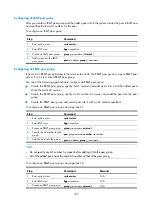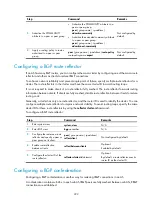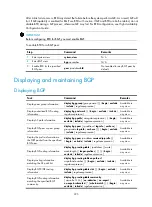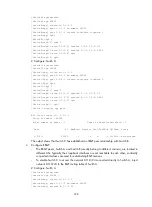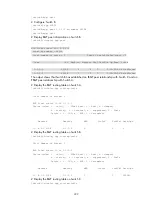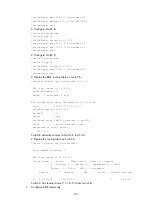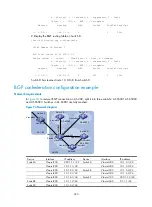
231
i 2.2.2.2/32 2.2.2.2 0 100 0 ?
*>i 3.1.1.0/24 2.2.2.2 0 100 0 ?
*>i 8.1.1.0/24 3.1.1.2 0 100 0 65008i
* i 9.1.1.0/24 2.2.2.2 0 100 0 ?
The output shows that the route 8.1.1.0 becomes valid with the next hop as Switch A.
5.
Verify the configuration:
# Ping 8.1.1.1 on Switch C.
[SwitchC] ping 8.1.1.1
PING 8.1.1.1: 56 data bytes, press CTRL_C to break
Reply from 8.1.1.1: bytes=56 Sequence=1 ttl=254 time=2 ms
Reply from 8.1.1.1: bytes=56 Sequence=2 ttl=254 time=2 ms
Reply from 8.1.1.1: bytes=56 Sequence=3 ttl=254 time=2 ms
Reply from 8.1.1.1: bytes=56 Sequence=4 ttl=254 time=2 ms
Reply from 8.1.1.1: bytes=56 Sequence=5 ttl=254 time=2 ms
--- 8.1.1.1 ping statistics ---
5 packet(s) transmitted
5 packet(s) received
0.00% packet loss
round-trip min/avg/max = 2/2/2 ms
BGP and IGP synchronization configuration example
Network requirements
As shown in
, all devices of company A belong to AS 65008, and all devices of company B
belong to AS 65009. AS 65008 and AS 65009 are connected through Switch A and Switch B. Switch
A must be able to access network 9.1.2.0/24 in AS 65009, and Switch C must access network 8.1.1.0/24
in AS 65008.
Figure 90
Network diagram
Configuration procedure
1.
Configure IP addresses for interfaces. (Details not shown.)
2.
Configure OSPF:
Enable OSPF in AS 65009, so that Switch B can obtain the route to 9.1.2.0/24.
# Configure Switch B.
<SwitchB> system-view
[SwitchB] ospf 1
[SwitchB-ospf-1] area 0
[SwitchB-ospf-1-area-0.0.0.0] network 2.2.2.2 0.0.0.0
[SwitchB-ospf-1-area-0.0.0.0] network 9.1.1.0 0.0.0.255




